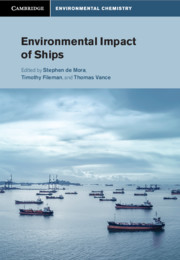Book contents
- Environmental Impact of Ships
- Cambridge Environmental Chemistry Series
- Environmental Impact of Ships
- Copyright page
- Contents
- Contributors
- Preface
- 1 Shipping, Ships and the Environment
- 2 Atmospheric Emissions from Ships
- 3 Oil Pollution from Operations and Shipwrecks
- 4 Waste and Sewage
- 5 Ballast Water
- 6 Biocides from Marine Coatings
- 7 Invasive Species
- 8 Physical Effects of Ships on the Environment
- 9 Ship Noise
- 10 Vessel Strikes and North Atlantic Right Whales
- 11 Nuclear-Powered Vessels
- 12 Environmental Impacts of Shipbreaking
- 13 International Legislative Framework
- 14 Shipping Industry’s Perspective
- 15 Environmental Impacts of Shipping
- Index
14 - Shipping Industry’s Perspective
Published online by Cambridge University Press: 22 January 2021
- Environmental Impact of Ships
- Cambridge Environmental Chemistry Series
- Environmental Impact of Ships
- Copyright page
- Contents
- Contributors
- Preface
- 1 Shipping, Ships and the Environment
- 2 Atmospheric Emissions from Ships
- 3 Oil Pollution from Operations and Shipwrecks
- 4 Waste and Sewage
- 5 Ballast Water
- 6 Biocides from Marine Coatings
- 7 Invasive Species
- 8 Physical Effects of Ships on the Environment
- 9 Ship Noise
- 10 Vessel Strikes and North Atlantic Right Whales
- 11 Nuclear-Powered Vessels
- 12 Environmental Impacts of Shipbreaking
- 13 International Legislative Framework
- 14 Shipping Industry’s Perspective
- 15 Environmental Impacts of Shipping
- Index
Summary
Reinforcing the view that shipping is indispensable to the world, this chapter briefly outlines the shipping industry’s perspective on a range of key topics, notably the issues tackled by the International Maritime Organization (IMO). The commitment of the shipping industry to the protection of the environment is unshaken. The global shipping industry fully respects the role of IMO as its global regulator and participates actively in the development of new and revised regulation to protect the environment. The industry’s focus is not on delaying regulation, but on ensuring that regulation is effective and fit for purpose. It is little recognized outside the industry that virtually every potential impact that a ship may have on its environment is already regulated to some degree under international law. Topics covered in the chapter includes the challenge of reducing CO2 emissions from shipping, the response to the sulfur cap in fuels and ballast water regulations. The chapter also considers ship recycling regulations. Finally, the desire is expressed to preserve the role of IMO as the unique specialist agency for regulating shipping in the face of the trend towards increasing national and regional regulation.
- Type
- Chapter
- Information
- Environmental Impact of Ships , pp. 352 - 366Publisher: Cambridge University PressPrint publication year: 2020

